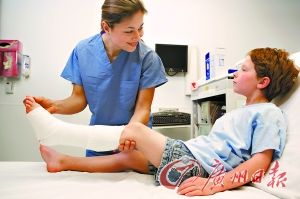Children's fracture regeneration ability is strong, not suitable for steel plate
● Recently, some medical experts bitterly criticized that a considerable part of fracture plate fixation is excessive treatment, which is a waste. Some experts also believed that whether to mount the plate or not should be analyzed according to the specific conditions of patients
● Some common lumbar compression fractures of the elderly can be recovered in bed, and children have strong regenerative ability. Steel plate is generally not suitable for fractures
I accidentally fell down and broke my leg. What should I do? Doctor A told you, "If you want to get better quickly, it is the best way to use steel plates." But Doctor B said, "It is unnecessary to use steel plates for this kind of fracture, and steel plates need to be cut, which may lead to infection and other complications. It is better to use plaster. Although the method is old, it works." It is believed that many citizens who have suffered from fractures have been a little overwhelmed by similar opinions of the two factions.
Recently, an orthopedic expert from Wuhan University severely criticized the abuse of "steel plate" in an interview with the media. He pointed out that the fracture patients who can be cured by plaster fixation, driven by the interests of the doctors, are fixed by surgery with "steel plates". More than 80% of fracture patients have taken steel plate treatment, but less than 60% of them really meet the indications. In other words, 20% of the steel plate treatment is a waste.
But is that really the case? As a patient, how should we choose when we meet the doctor's "steel plate" proposal? This reporter interviewed local orthopedic experts in Guangzhou.
Orthopaedic experts speak hard:
20% steel plate treatment is a waste
The fracture patients who can be cured by plaster fixation, driven by the interests of the doctors, are fixed by surgery with "steel plates". Professor Yu Aixi, chairman of Hubei Microsurgery Society and orthopaedic expert of Wuhan University Central South Hospital, pointed out that at present, there is improper use of steel plates in the treatment of fractures, which often leads to complications and increases the burden and pain of patients. More than 80% of fracture patients have taken steel plate treatment, but less than 60% of them really meet the indications.
Dr. Pan Zhenyu, the orthopaedic department of Central South Hospital, said that the hospital had recently admitted an orthopaedic patient transferred from other places. The patient had undergone plate fixation in the local emergency department 20 days ago due to traumatic fracture, and a large area of soft tissue necrosis occurred after the operation. The patient will face multiple operations such as removal of necrotic tissue, flap transposition, etc. If osteomyelitis occurs, the plate will also be taken out. In recent years, the number of patients with such sequelae admitted by the hospital has been on the rise. Pan Zhenyu introduced that in addition to plate fixation, the treatment of fractures also includes intramedullary nail fixation, external fixator fixation and plaster fixation, and the cost is relatively low. Blind "steel plate" will lead to bone exposure, osteomyelitis, bone nonunion and other sequelae.
Expert analysis
Steel plate OR gypsum
There is no best, only the most suitable
As for Professor Yu Aixi's remarks, Dr. Zhao Hongpu, Deputy Director of the Orthopaedics Department of the Third Affiliated Hospital of Guangzhou Medical College, pointed out that the internal fixation of steel plate, an orthopaedic treatment method, had only entered China since 1995. Before that, the fixation methods adopted by Chinese fracture patients were nothing more than two: plaster or splint. "From this point of view, plate fixation is really not an indispensable treatment method, because without it, many patients with closed limb fractures have achieved the goal of clinical treatment by relying on the most traditional fixation methods."
"However, as medicine is advancing, patients' requirements are also increasing." Zhao Hongpu said that the reason why steel plate fixation is used more and more in clinical practice cannot exclude the "benefit driven" factors criticized by Professor Yu Aixi, but a considerable part of them are patients' requirements. "For example, some patients hope that their bones will be the same after recovery as before the injury. Not only will their functions recover well, but they also hope that the appearance of the bones will heal seamlessly. However, this is impossible to do with plaster and splint fixation. At present, the only way to meet the requirements of patients is through open surgical reduction and then steel plate fixation."
In addition, the use of steel plate fixation can shorten the hospitalization and bed rest time of patients. Take the thigh fracture as an example. If manual reduction and plaster or splint fixation are used, the patient should stay in bed for at least two months, and cannot take a bath. It is also very inconvenient to urinate and urinate. However, if the plate is fixed and the operation is successful, the patient can be discharged in two weeks, and with the help of crutches, the patient can basically take care of himself or even go to work.
However, as everything has two sides, steel plate fixation also has its own unavoidable defects. "First of all, open surgery is required, so all risks related to surgery may occur, such as infection, and steel plate fixation also requires a second operation to remove the steel plate." Second, the cost problem is that steel plate fixation is often tens of thousands of yuan just for consumables, while plaster fixation, for example, for the lower limbs, is generally about 500 yuan.
"Therefore, whether it is steel plate fixation or plaster or splint fixation, there is no absolute difference between good and bad, and it is hard to say whether it is' excessive 'or' abuse '. The key is to analyze the specific situation of the patient, and there is no best, only the best." Zhao Hongpu said that as an orthopedic doctor, we should consider the quality, risk The expenses are introduced to the patients in detail to help them analyze their own conditions and give professional suggestions, so as to select the most appropriate treatment scheme.
case analysis
Reduction of complications by plate fixation for elderly fractures
Children's fracture regeneration ability is strong, not suitable for steel plate
So, what exactly is suitable for plaster or splint fixation and what is suitable for steel plate fixation?
Zhao Hongpu said that the clinical situation is so different that it is difficult to have a unified and absolute standard, but the two case studies he provided may bring some reference value to everyone.
The 78 year old Uncle Huang slipped in the bathroom at home a few days ago and broke his hip. Uncle Huang has chronic diseases such as hypertension and diabetes, but he usually controls them well through drug treatment. Uncle Huang is a retired civil servant who enjoys free medical treatment. In consideration of the above factors, the doctor suggested that Huang should implant a steel plate to fix the fracture site. Zhao Hongpu analyzed that surgical reduction and plate fixation can reduce the bedtime of the elderly. "Elderly people have slow bone growth and poor healing ability. If they receive plaster or splint fixation, they will often stay in bed for two or three months. If they stay in bed for a long time, they are prone to cardiovascular, cerebrovascular, respiratory and endocrine complications, such as cerebral thrombosis, pulmonary embolism, etc., which can be fatal."
Dongdong, a 5-year-old boy, was knocked down by a roller skating child while playing in a residential area, resulting in a fracture of his right forearm. "Generally speaking, we do not advocate the use of steel plate fixation for children's fractures." Zhao Hongpu said that because children's bones have strong regenerative capacity and grow fast, for example, if a newborn child has a clavicle fracture, sometimes it will grow well in a week, so it is not suitable to use invasive treatment such as surgery, as long as manual reduction, It is enough to fix it with plaster or splint. Even if it is really necessary to mount the steel plate, the time for the steel plate to stay in the body must be strictly controlled, and it cannot be too long, otherwise it will restrict the growth of the child's bones.
Expert Reminder
Careful selection of "bone cement" fixation
Zhao Hongpu also told reporters that there are many other fracture fixation methods besides plaster fixation, splint fixation and plate fixation. For example, "vertebroplasty", also called "bone cement injection", is very popular in many hospitals nowadays.
Zhao Hongpu said that most of the fixation methods for such fractures are used for patients with lumbar compression fractures, usually the elderly. Its principle is to inject a material called "bone cement" directly into the vertebral body of the fracture to strengthen and fix the fracture site from the inside. "Generally speaking, this treatment method is more suitable for the fracture at the thoracolumbar junction, and the effect is really good. But if the fracture is a little higher, close to the thorax, then the fracture is supported by the thorax, and the injury and symptoms are relatively minor, the patient can actually achieve the treatment goal after lying in bed for 3 to 5 weeks. Not only that, because this part belongs to the high position of the spine, and bone cement is a 'foreign body' after all, if it is injected at this part, it may lead to paralysis due to careless operation or other reasons, and the risk is relatively high, so it should be carefully selected. " Article/Reporter Li Heng Correspondent Liu Dan
Medical guidance/Dr. Zhao Hongpu, Deputy Director of the Second Area of Orthopaedic Department of the Third Affiliated Hospital of Guangzhou Medical College

![]()



